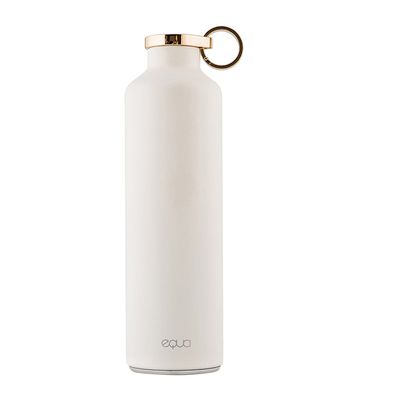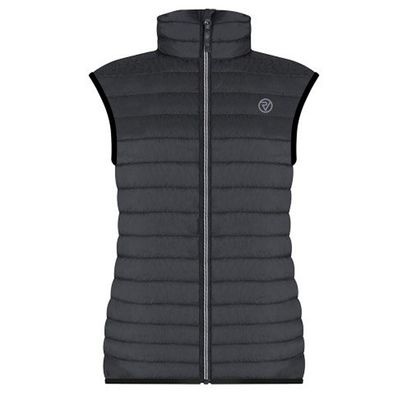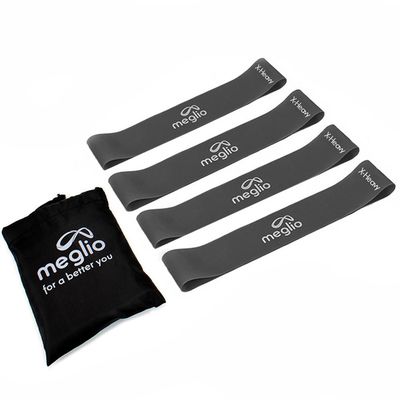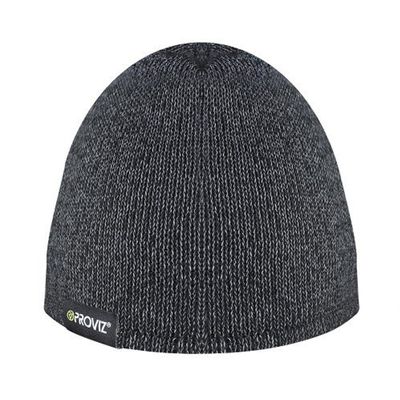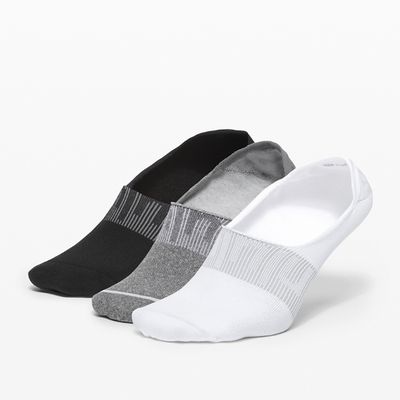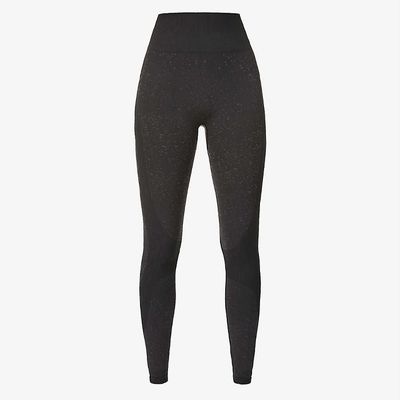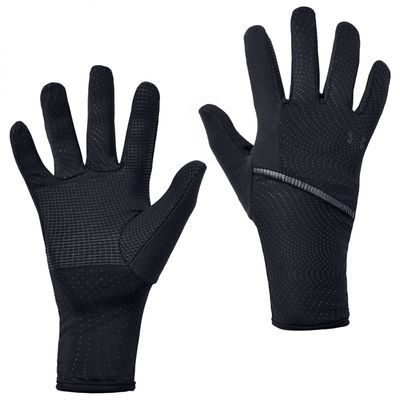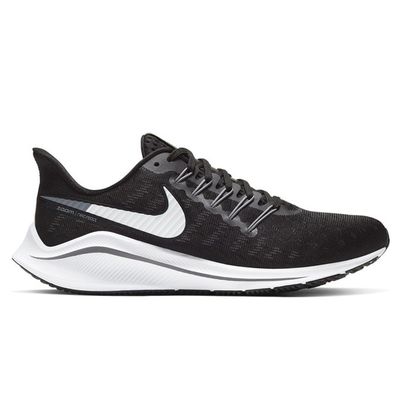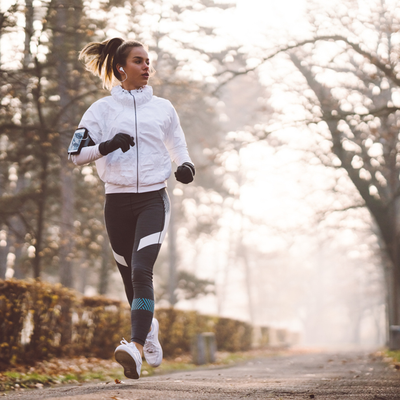
How To Stay Safe When Exercising Outdoors In Winter
Think About Kit
The number one rule when it comes to dressing for an outdoor winter workout is to think about layers and staying dry, as the quickest way to lose body heat is to get wet. Wet fabric next to your skin will zap body heat and give you an unwanted chill, so ditch cotton leggings or tops, which will just soak up sweat and rain and hold in moisture. “Start with a tightly fitted base that’s moisture-absorbing – something made from polyester is ideal,” says Kira Mahal, CEO of Motivate PT. “Your second and/or third layer is about insulation and protecting you from the cold. Your outer layer should be easy to discard off and able to protect you from the elements, such as a wind breaker or something with a hood in case it’s raining.” And while staying warm is key, don’t overdo the layers, says Sam Begg, triathlon and running coach for Meglio. “You should feel slightly too cold when you head out as within a few minutes of running, your body starts burning glycogen to produce energy, which releases heat.” Some experts say that as a rule of thumb, you should dress for weather ten degrees warmer than it really is.
Wear Bright Colours
An all-black ensemble may be your outfit of choice in the gym, but it pays to choose something a little brighter when heading out in the dark. “This is a no-brainer,” says personal trainer Aimee Victoria Long. “Lorna Jane do some great colourful pieces that are super stylish and made with breathable, moisture-wicking fabrics. If colourful workout gear isn’t for you, consider wearing light-reflective gear. Any major sports brand will do great reflective clothing, although it’s worth looking at Proviz, who do some great reflective running jackets.” Sam also stresses the importance of light-reflective gear: “By firing light back at motorists, it increases visibility over a greater distance – accompanied with small flashing LEDs, you can increase your visibility by up to ten times. Look for jackets or leggings with reflective detailing in key motion zones, such as the lower legs and arms.”
Protect Your Extremities
If it’s particularly chilly, think about wearing a decent pair of gloves and a hat, says Aimee. “Areas such as the fingers, ears, nose and toes are most affected by the cold because blood is shunted to the core when the temperature drops, leaving less blood and therefore less heat available to the extremities. If you’re someone who gets cold hands when running or exercising, try Under Armour’s Run Liner Gloves. Under Armour also have some great thermal leggings, which help blood flow through compression.” Sam also recommends investing in a pair of merino wool socks, which will keep your feet warm and dry in most conditions.
Prep The Night Before
If you tend to workout first thing, try putting your gear on the radiator overnight – it may sound simple, but trust us, a toasty pair of socks at 7am on a dark morning makes all the difference.
Move In The Right Direction
If you’re a keen runner and heading out either before sunrise or in the evening, try to run against the traffic so you can see everything that’s coming your way. This is particularly important if you’re running in an area where there aren’t any pavements. If you’re cycling, bike with the traffic and watch your speed, as the faster you’re going, the less time a driver has to react. “And where possible, train in the morning,” Kira recommends. “If you plan your workout with sunrise, it’ll get lighter as your session progresses, whereas if you go in the evening, it’ll already be dark. If you do head out in the dark, make sure your phone is fully charged, as it can double up as a torch, and if you’re going to the park, choose one that’s well lit, near a main road, or one that has a close entry and exit point.”
Don’t Jump Straight In
Warming up is an essential part of any workout, but is particularly important in colder weather when our muscles are colder, tighter and more susceptible to injury. “The ideal warm-up in cold weather is something aerobic,” Kira says. “This is important as it will elevate both your heart rate and temperature. Classic aerobic moves like jumping jacks, butt kicks, light running drills and short bursts of high knees are all good ways to warm up when it’s chilly. Follow this with some stretching and you’re good to go.” Sam recommends warming up with some resistance bands, renowned for their versatility. “Use them for squats, leg raises and crab walks, all of which are great for muscle activation prior to a cold weather session.”
Stay Hydrated
You may feel like you sweat less in cold weather, but don’t be fooled. Remember dehydration significantly increases your risk of injury and will slow down your performance (studies suggest being just 2% dehydrated can result in a 10-20% reduction in your performance). The experts say that if your workout isn’t lasting more than an hour then there’s no need to bring water with you, but remember to start your session hydrated and drink plenty afterwards. “Aim for at least 750ml in the two hours before your session,” Sam advises, “And remember that although you’re not as likely to overheat and dehydrate in the cold, running in multiple layers can cause you to sweat more than usual.” If you’re heading out on a long run in the cold, fill your bottle with warm water, which will quickly cool down to room temperature once your outdoors, making it easier to drink when the mercury plummets. Research has also shown chocolate milk is one of the best rehydration drinks, containing the perfect balance of sugars and electrolytes to aid dehydration – serve yours warm for the perfect post-workout refuel.
Breathe Better
Some people find it tricky to breathe properly when exercising in colder weather, especially if you’re asthmatic. “When it’s cold, try to avoid shallow, sharp breathing,” Kira says. “Winter air can feel very dry. The trick is to breathe through your nose as this instantly warms the air. You can also wrap a scarf around your nose and mouth as this will also help warm the air as you breathe.”
Download An App
Enlist the help of tech to keep you safe during your next outdoor session. Personal safety app BSafe comes highly rated, connecting you to your own list of ‘guardians’; you can use the app to activate an SOS button if you feel in danger, which then triggers the app to record your surroundings and send it to nominated people. The app will also issue a message to your guardians if you fail to make it home within a specified time period. Glympse works in a similar way, sharing your location with friends and family in real-time.
Stay safe with our product edit below...
For more information visit AimeeVictoriaLong.co.uk, MotivatePT.co.uk and MyMeglio.com
DISCLAIMER: Features published by SheerLuxe are not intended to treat, diagnose, cure or prevent any disease. Always seek the advice of your GP or another qualified healthcare provider for any questions you have regarding a medical condition, and before undertaking any diet, exercise or other health-related programme.
DISCLAIMER: We endeavour to always credit the correct original source of every image we use. If you think a credit may be incorrect, please contact us at info@sheerluxe.com.
